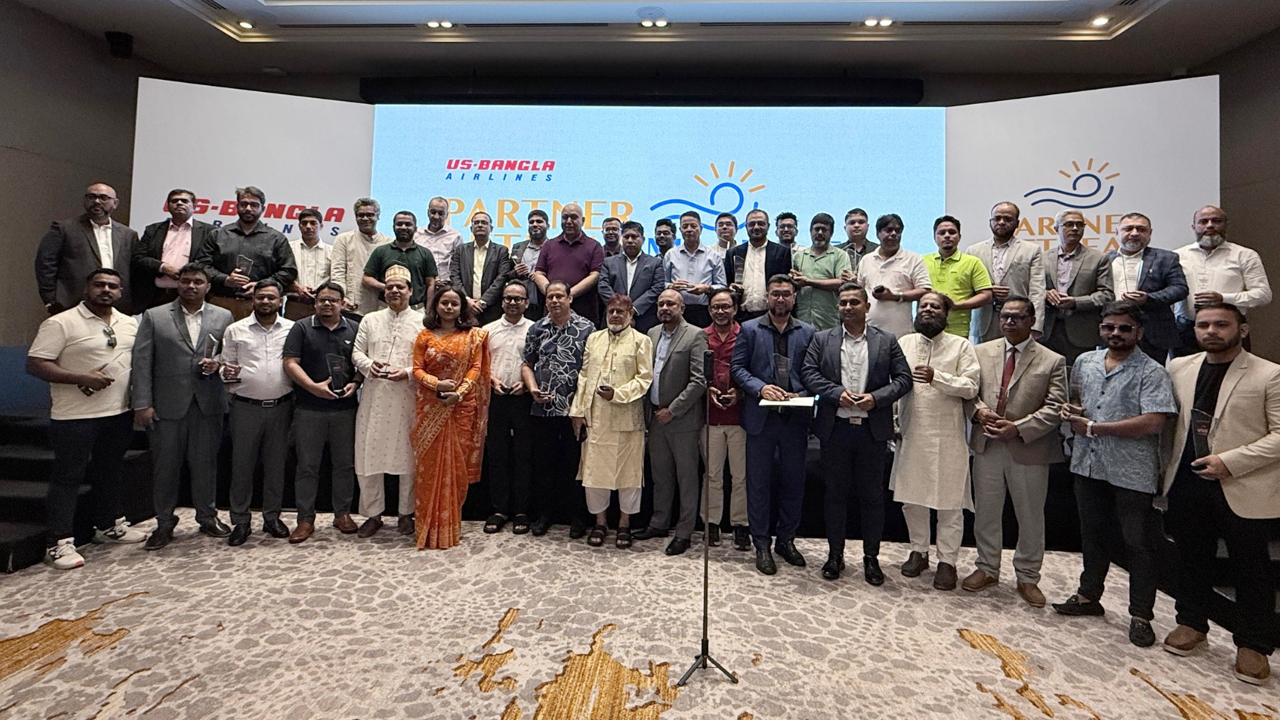Dhaka Airport Third Terminal : Transforming Bangladesh's Aviation
07 October 2023, 10:56 am

The grand inauguration of Dhaka Airport's 3rd terminal on October 7, 2023, signifies a monumental leap forward for Bangladesh's economy and infrastructure. This transformative project is set to have profound and far-reaching impacts on economic growth, job creation, and trade opportunities across the nation.
Key Details of Dhaka Airport Third Terminal
- Opening Date: October 7, 2023
- Construction Approval: Granted in December 2019
- Investors/Contractors: Leading the project are Mitsubishi and Fuji firms, along with the participation of South Korean businesses.
- Terminal Management: Japanese operations by ANA Holdings.
- Initial Cost Estimate: An estimated investment of Tk 21,300 crores.
- Architect: The interior design of the terminal is masterfully crafted by Rohani Bahrain.
Expansive Infrastructure: The expansion project encompasses a staggering 55,000 square meters of space spread across two meticulously designed floors. This space is dedicated to housing a state-of-the-art passenger terminal as well as a luxurious VVIP complex, complete with separate checkpoints and opulent waiting lounges. Upon its full realization, Dhaka Airport will ascend to the ranks of Asia's largest airports. Notably, it will boast world-class customer service amenities, including automated check-in counters and direct boarding bridges, ensuring an unparalleled travel experience.

Strategic Location and Connectivity: Dhaka Airport's strategic location makes it a pivotal hub, seamlessly connecting major cities and international destinations. This strategic advantage significantly augments the economic growth potential of the country.
Economic Significance: Modern airports are not merely transportation hubs; they are economic engines driving growth. Airports serve as gateways for passengers and cargo, facilitating trade, and catalyzing tourism. Furthermore, they attract foreign investments and create job opportunities. Enhanced airport infrastructure not only streamlines transportation but also augments trade and tourism, thanks to its cost-effective nature compared to other transportation modes.
Access to Major Cities and Global Destinations: The inauguration of the third terminal at Dhaka Airport greatly enhances accessibility to major cities within Bangladesh. This accessibility is expected to bring a surge of visitors, thereby stimulating economic activity. Moreover, with direct flights from Dhaka Airport to an array of international destinations, the potential for increased trade opportunities between nations is boundless. This, in turn, augments exports from Bangladesh and fuels job creation within the aviation industry.
Historical Development: The third terminal at Dhaka Airport marks a pivotal moment in its history, representing the most significant upgrade since its establishment in 1950. Beyond the infrastructural enhancements, it is set to redefine Bangladesh's image internationally, catalyze domestic trade, and reduce flight delays due to congested airports.
Job Creation and Revenue Generation: The third terminal is poised to be a significant generator of employment. During its construction phase alone, it is estimated to create over 5,000 jobs. Once operational, it will continue to foster economic growth by creating thousands more jobs, spanning diverse sectors. The new terminal is expected to increase revenue through heightened passenger traffic, more efficient cargo handling, and expanded export activities.
Enhanced Image: With the introduction of state-of-the-art amenities such as automatic check-in counters, advanced conveyor belts, and efficient boarding bridges, Dhaka Airport is poised to offer passengers world-class services. This, in turn, will elevate Bangladesh's image on the global stage.

Features of the Third Terminal
- Boasts a total of 26 boarding bridges and 115 check-in counters.
- Houses a plethora of state-of-the-art infrastructure.
- Equipped with flight information display systems.
- Implements an automated baggage handling system.
- Offers a spacious arrival lounge.
- Provides ample public seating areas.
- Features six dedicated business lounges for added convenience.
Comparison Between Terminals: Dhaka Airport now boasts three terminals, each catering to different travel needs, boasting unique features and facilities.
VIP and Cargo Terminals: The new third terminal also includes a state-of-the-art VIP terminal building and an advanced cargo handling facility. Located in proximity to international terminals, the VIP terminal is meticulously designed to cater exclusively to passengers seeking a luxurious experience. The cargo terminal, on the other hand, significantly enhances Bangladesh's export cargo handling capabilities, facilitating more efficient fuel supply, reduced aircraft turnaround times, and improved service delivery for exports.
Airlines and Destinations: Various airlines operate at Dhaka Airport, connecting Bangladesh to both domestic and international destinations. This extensive air connectivity fosters economic growth and trade opportunities.
Future Prospects: The completion of Dhaka Airport's third terminal positions it as a regional aviation powerhouse, offering enhanced connectivity, expanded cargo handling capacity, and top-tier infrastructure.
Benefits for Economy and Infrastructure: The third terminal's completion opens pathways for exponential economic growth, increased trade opportunities, and extensive infrastructure improvements across diverse sectors, including agriculture.
Challenges and Concerns: Despite its potential, the third terminal project faces certain challenges, such as construction delays, sustainability concerns, and financial management.
Sustainability and Regulation: To ensure sustainability, stringent regulations have been put in place to mitigate environmental impacts while fostering commercial success.
Financial Management: Effective financial management is imperative to prevent budget overruns and minimize debt risks, thereby ensuring the project's long-term sustainability.
Maintenance and Management: Sustaining the third terminal's quality and efficiency requires meticulous maintenance and management. This encompasses the regular upkeep and servicing of critical systems, such as luggage handling equipment, conveyor belts, boarding bridges, and check-in counters.
Impact on Agriculture: The third terminal is expected to eliminate disruptions in the export of fresh produce, significantly improving the efficiency and capabilities for handling perishable goods.
Potential for Future Development: The future holds promise, with discussions centered on projects like runway extensions and fleet expansions, aiming to bolster airline capacity and further enhance Bangladesh's connectivity.
In conclusion, Dhaka Airport's third terminal is not merely a construction project; it symbolizes Bangladesh's unwavering commitment to economic growth, infrastructural development, and global connectivity. Despite its challenges, its completion holds the key to a brighter and more prosperous future for the nation.
Frequently Asked Questions about Dhaka Airport Third Terminal
1. When will Dhaka Airport's 3rd Terminal start operations?
- The 3rd Terminal at Dhaka Airport is scheduled to start operations in early 2023, following its grand inauguration on October 7, 2023.
2. What is the investment estimate for Dhaka Airport's 3rd Terminal project?
- The estimated investment for the Dhaka Airport's 3rd Terminal project is Tk 21,300 crores.
3. What are the key features of Dhaka Airport's 3rd Terminal?
- The 3rd Terminal features 26 boarding bridges, 115 check-in counters, state-of-the-art infrastructure, flight information display systems, automated baggage handling, spacious arrival lounges, and six dedicated business lounges for passenger convenience.
4. How will Dhaka Airport's 3rd Terminal impact the economy of Bangladesh?
- The 3rd Terminal is expected to have a significant impact on Bangladesh's economy by creating jobs, boosting trade, attracting foreign investments, and facilitating tourism. It is set to become a major driver of economic growth.
5. What are the challenges associated with the construction of Dhaka Airport's 3rd Terminal?
- Some of the challenges include construction delays, sustainability concerns, and financial management. Effective regulation and financial oversight are crucial to overcoming these challenges.
6. How will the 3rd Terminal improve access to major cities and international destinations in Bangladesh?
- The 3rd Terminal will significantly enhance accessibility to major cities within Bangladesh and international destinations. It will lead to increased economic activity, trade opportunities, and better connectivity.
7. What is the significance of the VIP and Cargo Terminals at Dhaka Airport's 3rd Terminal?
- The VIP Terminal provides exclusive services for luxury travelers, while the Cargo Terminal enhances export cargo handling capabilities, ensuring efficient fuel supply and improved service delivery for exports.
8. What airlines operate at Dhaka Airport, and what destinations do they serve?
- Several airlines, including Bangladesh Biman, US-Bangla Airlines, Regent Airways, and international carriers like Emirates and Qatar Airways, operate at Dhaka Airport, connecting Bangladesh to various domestic and international destinations.
9. How will Dhaka Airport's 3rd Terminal impact the agriculture sector in Bangladesh?
- The 3rd Terminal is expected to reduce disruptions in the export of fresh produce and enhance the efficiency of handling perishable goods, benefiting the agriculture sector by reducing transit times and improving access to global markets.
10. What potential future developments are being discussed for Dhaka Airport's 3rd Terminal?
- Future developments may include runway extensions and fleet expansions to increase airline capacity and further enhance connectivity, fostering economic growth and development.





